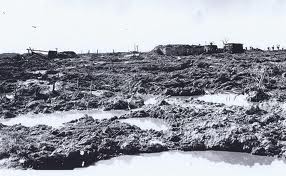I know the precise date when I first saw a television picture. It was 24th March 1951. How do you attribute this amazing display of memory? As is often the case, it is by association with a particular event. Our brand new 12 inch set was first switched on during the 1951 boat race and we witnessed Oxford sinking.
Another event from years ago that I remember seeing on TV was the great flood in Essex. This occurred precisely 60 years ago and there was a huge loss of life. It is surprising that those living in vulnerable properties were not warned to move out. I say this because I used to advise in North East Essex and a local farmer told me that he was in Harwich at low tide that fateful day and the water was already level with the top of the quay. However, I am experienced enough not to judge others on today’s standards. Hence, I shall not be apologising for recommending isoproturon for black-grass control in the past despite today’s knowledge about its possible impact on water biodiversity.
There were hundreds of acres of farmland inundated by the sea. In Essex, this was the old National Agricultural Advisory Service’s finest hour. They supervised the application of gypsum to overcome the impact of the salt on soil structure. They worked long hours and became skilled not only in getting the right quantity of gypsum to the right location but also in making sure that application was to the highest standard. Within a handful of years, soil structure was restored.

The muddy aftermath of the battle of Passchendaele
Of course soil structure can be badly affected in other ways. A good example is sugar beet harvesting this winter. There are fields out there that look like the photos of the aftermath of the battle of Passchendaele; a muddy and pot-holed landscape. In this case, the pot-holes have been caused by tyres and the even deeper ones by digging out vehicles.
The debate is what to do with these fields. How do you repair the damage? Perhaps the right question is what do we have to do in order to assist nature in overcoming the problem as quickly as possible.
There have been a series of meetings recently, sponsored by HGCA and Catchment Sensitive Farming, on repairing soil structure. The talks featured more general drainage and machinery issues and not the specific issue of the extreme damage done to some fields because of late harvesting of root crops. However, I was able to chat about this with the speakers after one of the events.
The context of the discussion was of course to find the most cost effective way of doing this over the next couple of years. Naturally, the ideal solution is to wait for the soil to dry out (assuming that we are bound to have a long dry spell at some stage this summer) and then to move the compacted layers as little as possible to ensure that nature can take its course. The latter will entail establishing a cover crop.
However, this will mean no crop in 2013. Hence, in discussion, a more pragmatic solution was agreed upon; an approach that many farmers have adopted in previous years. The first thing to accept is that leaving such an uneven surface will mean the lowest points (the ruts) will take for ever to dry out. Hence, despite all the potential downsides of running even more tyres (or hopefully tracks?) across the field, the land should be cultivated, just deep enough to lift the shallow ruts, as soon as possible in order to level the soil surface. Once it becomes sufficiently dry, a crop should be established after using shallow cultivations to prepare a seedbed. However, in the most extreme cases of soil damage it may perhaps be more judicious to sow a cover crop (e.g. mustard, fast growing grass) instead, particularly if the soil cannot be moved until very late spring.
Obviously the resulting crop is not going to be great but at least there will be something to sell and its roots will start doing the job of restoring soil structure. The crop choice is probably limited to cereals in most cases. After harvest, provided the soil is sufficiently dry, then deeper cultivations or sub-soiling or moling may be required to help restore structure. The decision on the depth of these cultivations will depend on the observations made after digging a few holes during the summer or immediately after harvest.
Observations of the aftermath of the wet winter of 2000/2001 would suggest that some soils will take perhaps a good two crop years before they are back to where they were before the damage caused by the late harvesting of root crops this winter. This is part of the inevitable cost of root crops and one that should never be discounted when doing crop budgets. The salutary fact is that many experts are saying that we will have to expect more extreme weather events in the future. So it is worth observing and recording the results of trying to overcome the problems caused by the wet root crop harvest of 2012.
